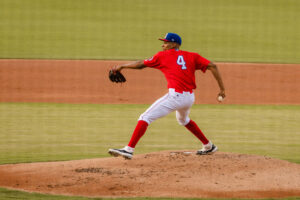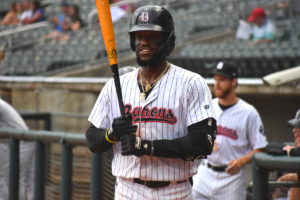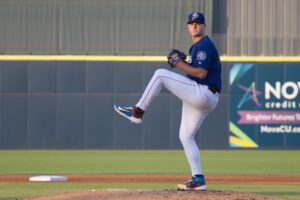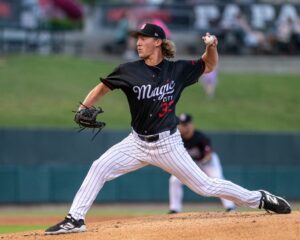FutureSox Rankings Roundtable: Writers' Highs and Lows
***Note added regarding Jordan Stephens’ pitches and a correction (1:59pm CT)***
Twice annually, our writers at FutureSox huddle and each provide their personal rankings of the current prospects. Then the fun really begins; we critique each others lists, ask questions, and share pertinent information we might have gleaned from sources or from in-person scouting trips. Inevitably this results in multiple lists, replacing the “rough draft” with a upgraded version until we finally get to our final result, the full White Sox top 30 list. While you, our dear readers, traditionally only see the finished product, we wanted to share some of our individual reasoning. So below, four of our writers discuss a player they were higher on than everyone else, one they were lower on than everyone else, and why in each case.
Matt Cassidy:
Highest: Spencer Adams
I saw Adams pitch in 2017, after seeing him in 2016 and 2015, so I’ve been able to watch the progression. I think in some ways he’s a forgotten man in the added wave of pitching talent. The complete package even as it stands today looks like a strong case for a back end starter – fastball in the 92-95 range with some movement, a mid-80’s slider that is back to almost as sharp as what got him drafted, a two-seam sinker and change-up that are playable. But here is the difference-maker to me – this kid just turned 21 during he 2017 season. He’s been improving his repertoire and results while years younger than the competition, and his body is still filling out. The potential is there, perhaps, for more like a 3rd/4th starter in the future. He reminds me a bit of Jon Garland. Spencer isn’t going to be a top of rotation arm by any means, but I’d put high chances on him being a major league starter for more than a quick September look.
Lowest: Jordan Stephens
For the record, I like Stephens as a prospect and wasn’t dramatically lower on him than others. He’s a bulldog whose stuff has never been spectacular, but he locates well and has just enough material to consistently get hitters out. He has a 4-pitch mix and none of them are weak, in fact all are at or near average and one or two could get above with time. My doubts fall into two categories. For one, especially now that he dropped the slider in favor of a cutter, I don’t see an out pitch or any single pitch that’s notably above average for him to lean on in the bigs. Then there are the health concerns – his forearm tendonitis in 2017 as a TJS survivor and his relatively small pitcher’s frame. He’s still a guy to watch and one who could contribute in the majors, but I think he’s more accurately ranked similarly to Jordan Guerrero, Ian Clarkin or AJ Puckett, as opposed to Adams and Carson Fulmer.
***NOTE: Jordan has informed us (after article was published) that he brought back the slider as the season went on.
James Fox:
Highest: Carson Fulmer
I had Carson Fulmer rated as the 10th best prospect in the White Sox system. While some of the prospect shine has worn off, I really couldn’t justify placing anyone else higher than him on the list. There is big time reliever risk with Fulmer but I was intrigued with what I saw in his brief stint with the major league club last year after posting the numbers he did in Charlotte. Fulmer got hit hard in AAA and also got pounded in his first start with the White Sox upon being called up. It’s a very small sample size and I normally try to disassociate from September stats as much as possible, but he got better. Excluding the clunker of a debut, Carson went on to post a 1.64 ERA in September. His stuff looked better than I expected and his proximity to the major leagues puts him higher on the list than fellow pitching prospects: Stephens, Adams, and Jordan Guerrero. He may end up in the bullpen but I think it’s more likely than I did before that he could pitch at the back end of a major league rotation. He needs to miss more bats and walk fewer hitters in 2018 and he should be able to best his 4.71 xFIP if he can consistently do so.
Lowest: Bernardo Flores
Southpaw Bernardo Flores made our top 30 list but was left off my personal list. His fastball has always fluctuated in velocity dating back to his days at the University of Southern California. It was part of the reason why he wasn’t drafted until round 7 in 2016. He has a #5 starter ceiling but he struggles with command and doesn’t have a put-away pitch to go along with his inconsistent fastball velocity. The 22-year-old left-hander pitched up into the mid 90’s during his first year in the organization but scouts have noted a dip in velocity that was one reason for some of his struggles this past season. He threw 78 innings in Kannapolis while striking out 8 hitters per 9 and posting a FIP of 3.33. Flores then struggled in 40.1 innings in High A with Winston-Salem. He struck out 7.36 per 9 innings and walked almost 5. He had a 4.79 FIP and was throwing his fastball in the high 80’s regularly according to some scouts. Flores is young enough to turn it around and he’s a lefty which helps but he wasn’t one of the 30 best prospects in a top 5 system once I compiled my rankings.
Owen Schoenfeld:
Highest: Seby Zavala
If Seby Zavala had been a first or second round pick, he likely would have made the top fifiteen on our list. Pedigree can go a long way in propping up subprime players or diluting the otherwise diamonds in the rough. On my personal list, Zavala actually snagged the last spot in the Top 10. It’s important to remember he missed a full year at San Diego St. due to Tommy John Surgery, so developmentally he’s about a year behind the curve. Since becoming a pro, he’s simply hit, hit, and hit some more. It started with a 1.029 OPS in Rookie Ball and culminated with an .851 OPS across two levels last season. The one blemish on his resume is an injury-riddled 2016, where he scuffled to a .711 OPS but still managed a .330 OBP. To call last season a breakout fails to recognize a fairly solid player simply playing in the shadow of Zack Collins. Was an org leading 21 home runs all that surprising? Maybe, but for a guy who lifts the ball with regularity and sports a quick-to-the-ball stroke, it’s not an aberration. At 24 years old, Zavala has to show he can hit the breaking stuff he’ll soon see in Double-A and above. His hot burst in the AFL was a good sign, but to win over doubters he’ll need to sustain it across a full season. Defensively, pitchers rave about throwing to him and while he’s not flashy blocking pitches, he can play as passable. Make no mistake; this is a bat-driven profile, but one with projection. If the 10-percent walk-rate he posted to close out the year is closer to his new normal, then Zavala will be that much more interesting. The floor is a part-time 1B/DH but the ceiling is a catcher who can slash .275/.325 with 15-20 HRs.
Lowest: Luis Gonzalez
I was the lowest of the bunch on 2017 3rd rounder and OF Luis Gonzalez. It’s less about him in isolation and more a function of preference for the guys ahead of him. This list became a lot more malleable after about #15 and divides were perpetuated by some subjectivity surrounding how certain tools are valued. Fellow FS writer James Fox challenged me on ranking Gonzalez behind a couple relievers, namely Ian Hamilton and Thyago Vieira. Viewing prospects in a vacuum may be pragmatic but that rationale goes out the window when you’re dealing with a sequential ranking rather than a one-off analysis. Strictly from a scarcity perspective, especially in this system, relievers have a bit more value. Not a middle reliever per se, but in Hamilton and Vieira the White Sox sport two potential backend options. Thyago’s fastball will get him to the big leagues. Hamilton’s ability to miss bats and get ground balls with a two-pitch combo make him a decent bet too. These tools were simply louder than any single element of Gonzalez, who is propped up by the whole of his profile more than any one skill. The system is flooded with similar outfielders with Alex Call and Ryan Cordell ahead of him. The hit tool was enough to get him into the top 30 in Chicago’s best system to date, but toe to toe, a backend reliever close to the bigs is simply a higher ceiling than a projected 4th outfielder who is currently in low-A.
Rob Young:
Highest: Luis Gonzalez
When set to the task of ranking this system, the top 10 is full of eye-popping BP sessions, wicked plus pitches, draft pedigrees and signing bonuses that would make any talent evalutor flush in excitement. But beyond the top part of the list, there are players with big tools and equally big question marks and it was really a mixed bag on who belongs in that next tier of prospects. When I was evaluating the system, the name that kept rising into that tier was 2017 3rd round pick, Luis Gonzalez. The term “five tool player” is tossed around liberally among pundits and fans, but Gonzalez has a truly diverse skill set that differentiates him from his peers. Unlike previously drafted toolsy outfielders, Gonzalez has an outstanding hit tool, consistently makes loud contact to all fields, and controls the strike zone. His plate discipline is advanced, evidenced by him finishing sixth in all of D-I baseball with 58 walks his last season in college and collecting 42 more free passes in pro ball. In addition to a high on base percentage, he also hits for power. 37.6% of Gonzalez’s hits were of the extra base variety, combining his college and pros stats last year. Defensively Gonzalez can patrol center field, a premium position on the baseball diamond that teams struggle to find competent production for. Put all these factors together and you have a dynamic prospect with a high floor that I believe is a breakout candidate for the system in 2018.
Lowest: Jordan Guerrero
There is a lot to like about Jordan Guerrero so I’ll start with the good news. After struggling in AA Birmingham in 2016, he improved across the board when he repeated the level in 2017. Walks went down, strikeouts up, ERA improved, he threw 10.1 more innings, and reportedly added a slider to his repertoire. As a 23-year-old lefty who just had a productive season in AA with a four pitch mix, he is definitely a prospect and worthy of being on the top 30 list. The bad news? His ERA and WHIP improved, but marginally, going from 4.83 to 4.18 and 1.51 to 1.31 respectively. As evidenced by the high ERA and WHIP, he was very hittable, giving up 150 knocks in 146.1 innings. The White Sox also elected to not protect him from selection in the Rule V draft and their risk was justified, as he surprisingly was not plucked by another team. I believe Jordan Guerrero will ultimately be a big leaguer, but wasn’t as aggressive ranking him as some of my cohorts.
Want to know right away when we publish a new article? Type your email address in the box and click the “create subscription” button. Our list is completely spam free, and you can opt out at any time.






